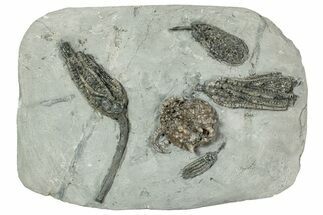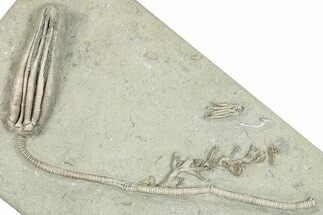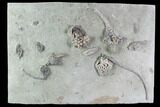This Specimen has been sold.
Stunning 11.7" Crinoid Plate - Eight Species - Crawfordsville
This is a spectacular crinoid association from the Edwardsville Formation near Crawfordsville, Indiana, with twelve individual specimens present representing eight different species. All are preserved 3D and have been prepared with air abrasives. This is a natural association and none of the specimens are composites.
It comes with an acrylic display stand.
Identification by #:
2 - Abrotocrinus unicus
17 - Cyathocrinites multibrachiatus
19 - Cyathocrinites kelloggi
26 - Goniocrinus harrisi
30 - Hylodecrinus asper
47 - Scytalocrinus decadactylus
52 - Actinocrinites gibsoni
69 - Macrocrinus mundulus
It comes with an acrylic display stand.
Identification by #:
2 - Abrotocrinus unicus
17 - Cyathocrinites multibrachiatus
19 - Cyathocrinites kelloggi
26 - Goniocrinus harrisi
30 - Hylodecrinus asper
47 - Scytalocrinus decadactylus
52 - Actinocrinites gibsoni
69 - Macrocrinus mundulus
Crinoids from the Ramp Creek Limestone were likely buried in sediment from nearby deltas during storms. The resulting siltstone deposits are soft enough that fossils can be extracted in exquisite, three-dimensional relief.
Crinoids, sometimes commonly referred to as sea lilies, are animals, not plants. They are echinoderms related to starfish, sea urchins, and brittle stars. Many crinoid traits are like other members of their phylum. Such traits include tube feet, radial symmetry, a water vascular system, and appendages in multiples of five (pentameral). They first appeared in the Ordovician (488 million years ago) and some species are still alive today.
Crinoids, sometimes commonly referred to as sea lilies, are animals, not plants. They are echinoderms related to starfish, sea urchins, and brittle stars. Many crinoid traits are like other members of their phylum. Such traits include tube feet, radial symmetry, a water vascular system, and appendages in multiples of five (pentameral). They first appeared in the Ordovician (488 million years ago) and some species are still alive today.
SPECIES
Macrocrinus mundulus & others
AGE
LOCATION
Crawfordsville, Indiana
FORMATION
Edwardsville Formation
SIZE
Rock 11.7 x 7.8"
CATEGORY
SUB CATEGORY
ITEM
#95190
We guarantee the authenticity of all of our specimens.
 Reviews
Reviews













